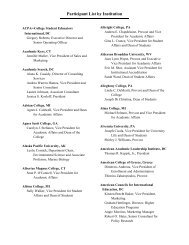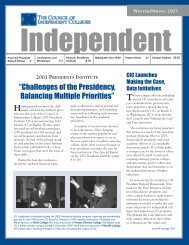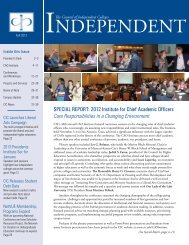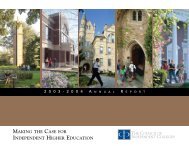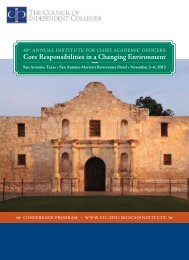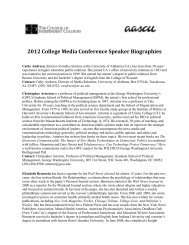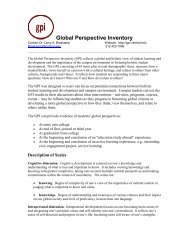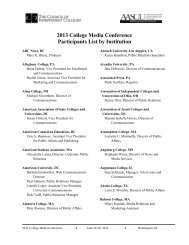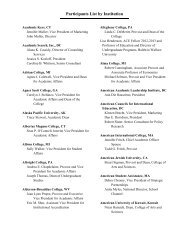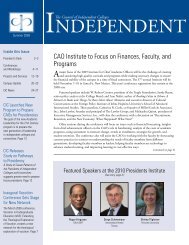Meeting the Challenge: - The Council of Independent Colleges
Meeting the Challenge: - The Council of Independent Colleges
Meeting the Challenge: - The Council of Independent Colleges
You also want an ePaper? Increase the reach of your titles
YUMPU automatically turns print PDFs into web optimized ePapers that Google loves.
John R. <strong>The</strong>lin<br />
In American higher education, imitation is a form<br />
<strong>of</strong> flattery. Presidents <strong>of</strong> <strong>the</strong> great state universities have<br />
repeatedly looked to small private colleges as models to<br />
reform undergraduate education in <strong>the</strong> public “knowledge<br />
factories.” <strong>The</strong>ir innovations tacitly acknowledge that<br />
<strong>the</strong> liberal arts campus remains an admirable setting for<br />
undergraduate education. Clark Kerr, legendary president<br />
<strong>of</strong> <strong>the</strong> multi-campus University <strong>of</strong> California system, who<br />
<strong>of</strong>ten invoked favorably his own undergraduate experience<br />
at Swarthmore College, had great hopes in 1965 for <strong>the</strong><br />
newly opened campus <strong>of</strong> <strong>the</strong> University <strong>of</strong> California at Santa<br />
Cruz to create diversity within <strong>the</strong> large state university.<br />
Kerr and his colleagues sought a new structure that would<br />
allow <strong>the</strong> “university to seem smaller as it grew larger.” Even<br />
though <strong>the</strong> University <strong>of</strong> California, University <strong>of</strong> Michigan,<br />
and o<strong>the</strong>r large state institutions struggled to rediscover<br />
<strong>the</strong> appeal <strong>of</strong> small size for undergraduate education, few<br />
<strong>of</strong> <strong>the</strong>se initiatives to humanize <strong>the</strong> scale <strong>of</strong> undergraduate<br />
education—such as creating experimental colleges or cluster<br />
colleges in <strong>the</strong> state universities—took root. Only a dozen<br />
public, genuinely liberal arts colleges exist today, although a<br />
new wave <strong>of</strong> imitation can be seen in <strong>the</strong> recent establishment<br />
<strong>of</strong> honors colleges within large universities. Meanwhile,<br />
independent colleges continued to refine <strong>the</strong>ir vision <strong>of</strong> small<br />
campuses with vital communities and rich curricula.<br />
A Carnegie<br />
Corporation<br />
study, Struggle<br />
and Promise: A<br />
Future for <strong>the</strong><br />
<strong>Colleges</strong> (1969),<br />
commended<br />
institutions such<br />
as Berea College<br />
for <strong>the</strong>ir intensive<br />
self-studies and<br />
institutional<br />
adaptations.<br />
17



